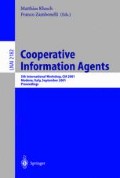Abstract
In recent years auctions have become more and more important in the field of multiagent systems as useful mechanisms for resource allocation, task assignment and last but not least electronic commerce. In many cases the Vickrey (second-price sealed-bid) auction is used as a protocol that prescribes how the individual agents have to interact in order to come to an agreement. The main reasons for choosing the Vickrey auction are the existence of a dominant strategy equilibrium, the low bandwidth and time consumption due to just one round of bidding and the (theoretical) privacy of bids. This paper specifies properties that are needed to ensure the accurate and secret execution of Vickrey auctions and provides a classification of different forms of collusion.We approach the two major security concerns of the Vickrey auction: the vulnerability to a lying auctioneer and the reluctance of bidders to reveal their private valuations. We then propose a novel technique that allows to securely perform second-price auctions. This is achieved using the announcement of encrypted binary bidding lists on a blackboard. Top-down, bottom-up and binary search techniques are used to interactively find the second highest bid step by step without revealing unnecessary information.
Access this chapter
Tax calculation will be finalised at checkout
Purchases are for personal use only
Preview
Unable to display preview. Download preview PDF.
References
O. Baudron and J. Stern. Non-interactive private auctions. In Pre-Proceedings of Financial Cryptography 2001, pages 300–313, 2001.
F. Brandt, W. Brauer, and G. Weiβ. Task assignment in multiagent systems based on Vickrey-type auctioning and leveled commitment contracting. In M. Klusch and L. Kerschberg, editors, Cooperative Information Agents IV, volume 1860 of Lecture Notes in Artificial Intelligence, pages 95–106, Berlin et al., 2000. Springer-Verlag.
F. Brandt and G. Weiβ. Vicious strategies for Vickrey auctions. In Proceedings of the 5th International Conference on Autonomus Agents, pages 71–72. ACM Press, 2001.
K. Danielsen and M. Weiss. User control modes and IP allocation. http://www.press.umich.edu/jep/works/DanieContr.html, 1995. presented at MIT Workshop on Internet Economics.
K.E. Drexler and M.S. Miller. Incentive engineering for computational resource management. In B.A. Huberman, editor, The Ecology of Computation. The Netherlands, 1988.
J. Ferber. Multi-Agent Systems. An Introduction to Distributed Artificial Intelligence. John Wiley & Sons Inc., New York, 1999.
M.K. Franklin and M.K. Reiter. The design and implementation of a secure auction service. IEEE Trans. on Software Engineering, 22(5):302–312, 1996.
M. Harkavy, J.D. Tygar, and H. Kikuchi. Electronic auctions with private bids. In Proceedings of the 3rd USENIX Workshop on Electronic Commerce, pages 61–74, 1998.
B. Huberman and S.H. Clearwater. A multiagent system for controlling building environments. In Proceedings of the 1st International Conference on Multiagent Systems (ICMAS-95), pages 171–176, Menlo Park, CA, 1995. AAAI Press.
M. Jakobsson and A. Juels. Mix and match: Secure function evaluation via ciphertexts. In Proceedings of Asiacrypt-00, pages 162–177, 2000.
H. Kikuchi. (M+1)st-price auction protocol. In Proceedings of Financial Cryptography (FC 2001), 2001.
H. Kikuchi, S. Hotta, K. Abe, and S. Nakanishi. Resolving winner and winning bid without revealing privacy of bids. In Proceedings of the International Workshop on Next Generation Internet (NGITA), pages 307–312, 2000.
M. Kudo. Secure electronic sealed-bid auction protocol with public key cryptography. IEICE Trans. Fundamentals, E81-A(1), 1998.
R.P. McAfee and J. McMillan. Auctions and Bidding. Journal of Economic Literature, 25:699–738, 1987.
P.R. Milgrom and R.J. Weber. A Theory of Auctions and Competitive Bidding. Econometrica, 50:1089–1122, 1982.
G.M.P. O’Hare and N.R. Jennings, editors. Foundations of Distributed Artificial Intelligence. John Wiley’ Sons Inc., New York, 1996.
M.H. Rothkopf and R.M. Harstad. Two models of bid-taker cheating in Vickrey auctions. Journal of Business, 68(2):257–267, 1995.
M.H. Rothkopf, T.J. Teisberg, and E.P. Kahn. Why are Vickrey auctions rare? Journal of Political Economy, 98(1):94–109, 1990.
T.W. Sandholm. Limitations of the Vickrey auction in computational multiagent systems. In Proceedings of the 2nd International Conference on Multiagent Systems (ICMAS-96), Menlo Park, CA, 1996. AAAI Press.
A. Shamir. How to share a secret. Communications of the ACM, 22:612–613, 1979.
D.X. Song and J.K. Millen. Secure auctions in a publish/subscribe system. Available at http://www.csl.sri.com/users/millen/, 2000.
W. Vickrey. Counter speculation, auctions, and competitive sealed tenders. Journal of Finance, 16(1):8–37, 1961.
.C.A. Waldspurger, T. Hogg, B. Huberman, J.O. Kephart, and W.S. Stornetta. Spawn: A distributed computational economy. IEEE Transactions on Software Engineering, 18(2):103–117, 1992.
G. Weiβ, editor. Multiagent Systems. A Modern Approach to Distributed Artificial Intelligence. The MIT Press, Cambridge, MA, 1999.
A.C. Yao. How to generate and exchange secrets. In Proceedings of the 27th Symposium on Foundations of Computer Science, pages 162–167. IEEE Computer Society Press, 1986.
Author information
Authors and Affiliations
Editor information
Editors and Affiliations
Rights and permissions
Copyright information
© 2001 Springer-Verlag Berlin Heidelberg
About this paper
Cite this paper
Brandt, F. (2001). Cryptographic Protocols for Secure Second-Price Auctions. In: Klusch, M., Zambonelli, F. (eds) Cooperative Information Agents V. CIA 2001. Lecture Notes in Computer Science(), vol 2182. Springer, Berlin, Heidelberg. https://doi.org/10.1007/3-540-44799-7_16
Download citation
DOI: https://doi.org/10.1007/3-540-44799-7_16
Published:
Publisher Name: Springer, Berlin, Heidelberg
Print ISBN: 978-3-540-42545-8
Online ISBN: 978-3-540-44799-3
eBook Packages: Springer Book Archive

